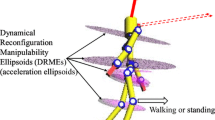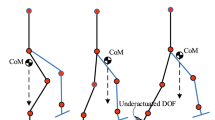Abstract
In this paper, a novel manipulability based three-level hierarchical approach is suggested for control of perturbed bipedal walking. An appropriate postural strategy is selected to restore stability if a perturbation occurs during steady-state human walking. Previous experimental studies on the human walking suggest that the selection of stabilizing strategies can be related to the kinematic manipulability of swing foot. The proposed three-level structure consists of a low, middle, and high levels. The manipulability is at the high-level layer. Therefore, in case of disturbance it determines to lengthen the step (elevating strategy) or shorten the step length (lowering strategy). The middle-level layer determines the optimal desired trajectories for joints. Finally, a low-level controller tracks the desired optimal trajectory to maintain stability. The results show the success of the manipulability based adapted control scheme against pushing perturbation. A comparison between the optimal gait patterns obtained with and without consideration of manipulability is also presented in this study. The results show that the manipulability improves disturbance rejection capability. Positioning the manipulability in the high-level of our proposed method mitigates the possibility of singularity occurrence and configuration limits during postural response.
Similar content being viewed by others
References
Y. Wang and M. Srinivasan, “Stepping in the direction of the fall: the next foot placement can be predicted from current upper body state in steady-state walking,” Biology letters, vol. 10, no. 9, p. 20140405, 2014.
M.-B. Radac and R.-E. Precup, “Three-level hierarchical model-free learning approach to trajectory tracking control,” Engineering Applications of Artificial Intelligence, vol. 55, pp. 103–118, 2016.
J. J. Eng, D. A. Winter, and A. E. Patla, “Intralimb dynamics simplify reactive control strategies during locomotion,” Journal of Biomechanics, vol. 30, no. 6, pp. 581–588, 1997.
Z. Potocanac, M. Pijnappels, S. Verschueren, J. van Dieën, and J. Duysens, “Two-stage muscle activity responses in decisions about leg movement adjustments during trip recovery,” Journal of neurophysiology, vol. 115, no. 1, pp. 143–156, 2015.
B. Miripour Fard, “A manipulability analysis of human walking,” Journal of Biomechanics, vol. 83, pp. 157–164, 2019.
B. M. Fard and S. M. Bruijn, “On the manipulability of swing foot and stability of human locomotion,” Multibody System Dynamics, 2019. DOI: https://doi.org/10.1007/s11044-018-09664-y
T. Yoshikawa, “Manipulability of robotic mechanisms,” The international journal of Robotics Research, vol. 4, no. 2, pp. 3–9, 1985.
T. Bhattacharjee, Y. Oh, J.-H. Bae, and S.-R. Oh, “Control design for human-like reaching movements using redundancy in robot arm-trunk systems,” International Journal of Control, Automation and Systems, vol. 9, no. 6, pp. 1173–1186, 2011.
I. A. Gravagne and I. D. Walker, “Manipulability, force, and compliance analysis for planar continuum manipulators,” IEEE Transactions on Robotics and Automation, vol. 18, no. 3, pp. 263–273, 2002.
T. Yoshikawa, “Dynamic manipulability of robot manipulators,” Transactions of the Society of Instrument and Control Engineers, vol. 21, no. 9, pp. 970–975, 1985.
J. Jacquier-Bret and N. Rezzoug, and P. Gorce, “Effect of spinal cord injury at c6-c7 on global upper-limb coordination during grasping: Manipulability approach,” IRBM, vol. 34, no. 1, pp. 69–73, 2013.
H. Endo, “Application of robotic manipulability indices to evaluate thumb performance during smartphone touch operations,” Ergonomics, vol. 58, no. 5, pp. 736–747, 2015.
I. Lee and J.-H. Oh, “Humanoid posture selection for reaching motion and a cooperative balancing controller,” Journal of Intelligent & Robotic Systems, vol. 81, no. 3–4, pp. 301–316, 2016.
J. Lenarčič and N. Klopčar, “Positional kinematics of humanoid arms,” Robotica, vol. 24, no. 1, pp. 105–112, 2006.
T. Maneewarn and A. Boonprakob, “Walking pattern modification using manipulability ellipsoid for biped robot,” Proc. of IEEE International Conference on Robotics and Biomimetics, ROBIO 2008, IEEE, pp. 160–165, 2009.
V. Samy and A. Kheddar, “Falls control using posture reshaping and active compliance,” Proc. of IEEE-RAS 15th International Conference on Humanoid Robots (Humanoids), IEEE, pp. 908–913, 2015.
Y. Tagawa and T. Yamashita, “Controllability of body motion in bipedal locomotion,” Proceedings of IEEE/RSJ International Workshop on Intelligent Robots and Systems ‘(IROS’ 89)’ The Autonomous Mobile Robots and Its Applications, IEEE, pp. 180–186, 1989.
Y. Gu, C. G. Lee, and B. Yao, “Feasible center of mass dynamic manipulability of humanoid robots,” Proc. of IEEE International Conference on Robotics and Automation (ICRA), IEEE, pp. 5082–5087, 2015.
V. Padois, S. Ivaldi, J. Babič, M. Mistry, J. Peters, and F. Nori, “Whole-body multi-contact motion in humans and humanoids: advances of the codyco european project,” Robotics and Autonomous Systems, vol. 90, pp. 97–117, 2017.
N. Naksuk and C. G. Lee, “Zero moment point manipulability ellipsoid,” Proc. of IEEE International Conference on Robotics and Automation (ICRA 2006), IEEE, pp. 1970–1975, 2006.
A. Escande, N. Mansard, and P.-B. Wieber, “Hierarchical quadratic programming: Fast online humanoid-robot motion generation,” The International Journal of Robotics Research, vol. 33, no. 7, pp. 1006–1028, 2014.
L. Sentis, J. Park, and O. Khatib, “Compliant control of multicontact and center-of-mass behaviors in humanoid robots,” IEEE Transactions on Robotics, vol. 26, no. 3, pp. 483–501, 2010.
N. Hu, S. Li, and F. Gao, “Multi-objective hierarchical optimal control for quadruped rescue robot,” International Journal of Control, Automation and Systems, vol. 16, no. 4, pp. 1866–1877, 2018.
A. Zaidi, N. Rokbani, and A. M. Alimi, “A hierarchical fuzzy controller for a biped robot,” Proc. of International Conference on Individual and Collective Behaviors in Robotics (ICBR), IEEE, pp. 126–129, 2013.
S. M. Kasaei, N. Lau, A. Pereira, and E. Shahri, “A reliable model-based walking engine with push recovery capability,” Proc. of IEEE International Conference on Autonomous Robot Systems and Competitions (ICARSC), IEEE, pp. 122–127, 2017.
S. Feng, Online Hierarchical Optimization for Humanoid Control, Ph.D. Dissertation, Carnegie Mellon University, 2016.
F. Plestan, J. W. Grizzle, E. R. Westervelt, and G. Abba, “Stable walking of a 7-dof biped robot,” IEEE Transactions on Robotics and Automation, vol. 19, no. 4, pp. 653–668, 2003.
B. M. Fard, A. Bagheri, and N. Nariman-Zadeh, “Limit cycle walker push recovery based on a receding horizon control scheme,” Proceedings of the Institution of Mechanical Engineers, Part I: Journal of Systems and Control Engineering, vol. 226, no. 7, pp. 914–926, 2012.
J. J. Eng, D. A. Winter, and A. E. Patla, “Strategies for recovery from a trip in early and late swing during human walking,” Experimental Brain Research, vol. 102, no. 2, pp. 339–349, 1994.
S. Leclercq, “Prevention of same level falls: a more global appreciation of this type of accident,” Journal of Safety Research, vol. 30, no. 2, pp. 103–112, 1999.
C. Chevallereau and Y. Aoustin, “Optimal reference trajectories for walking and running of a biped robot,” Robotica, vol. 19, no. 5, pp. 557–569, 2001.
A. Zelei, L. L. Kovács, L. Bencsik, and G. Stépán, “Computed torque control of underactuated dynamical systems modeled by natural coordinates,” Proceedings of the 7th International Conference on Mechanical Engineering. Gépészet, pp. 25–26, 2010.
D. G. Hobbelen and M. Wisse, “A disturbance rejection measure for limit cycle walkers: The gait sensitivity norm,” IEEE Transactions on Robotics, vol. 23, no. 6, pp. 1213–1224, 2007.
D. A. Winter, Biomechanics and Motor Control of Human movement, John Wiley & Sons,2009.
Author information
Authors and Affiliations
Corresponding author
Additional information
Recommended by Editor Doo Yong Lee.
Behnam Miripour Fard received his BSc degree in Mechanical Engineering from the University of Guilan, Rasht, Iran in 2005, his MSc degree in Mechanical Engineering from the Bu-Ali Sina University, Hamedan, Iran, in 2008, and his Ph.D. degree in Mechanical Engineering from the University of Guilan, Rasht, Iran in 2013. From Apr. 2012 to Oct. 2012, he was a visiting PhD Student at Robotics Institute of Carnegie Mellon University, Pittsburgh, PA, USA. Between 2013 and 2018 he served as an assistant professor and the head of the robotics department of the Hamedan university of technology, Hamedan, Iran. He is currently an Assistant Professor of the faculty of mechanical engineering at the University of Guilan, Rasht, Iran. His research interests include; biomechanics, path planning and control of humanoid biped robots, and bio-mimetic approaches in robotics.
Mohamad Mosadeghzad received his B.Sc. in Mechanical Engineering, Solid Design, and M.Sc. in Mechanical Engineering, Applied Design, from Bu-Ali Sina University, Hamedan, Iran, in 2005 and 2008. He also received his Ph.D. in Robotics, Cognition and Interaction Technologies from Italian Institute of Technology (IIT) and Genoa University, Genoa, Italy, in 2014. From 2015 to 2016, he was a post-doctoral fellow and research assistant in the Cognitive Robotics laboratory of the Canadian Centre of Behavioral Neuroscience (CCBN), University of Lethbridge, Canada. He is currently an assistant professor in the Department of Robotics and Mechatronics, Nazarbayev University, Astana, Kazakhstan. His research interests include humanoids, control, rehabilitation, and cognitive robotics.
Publisher’s Note
Springer Nature remains neutral with regard to jurisdictional claims in published maps and institutional affiliations.
Rights and permissions
About this article
Cite this article
Fard, B.M., Mosadeghzad, M. Manipulability Based Hierarchical Control of Perturbed Walking. Int. J. Control Autom. Syst. 17, 2343–2353 (2019). https://doi.org/10.1007/s12555-018-0577-9
Received:
Revised:
Accepted:
Published:
Issue Date:
DOI: https://doi.org/10.1007/s12555-018-0577-9




